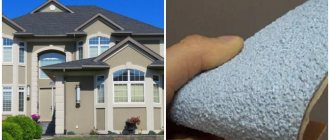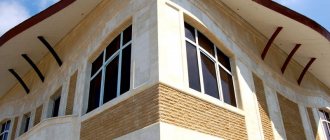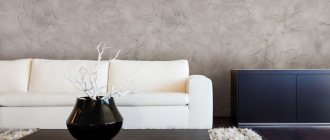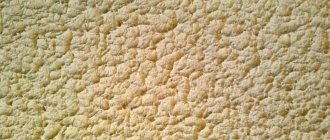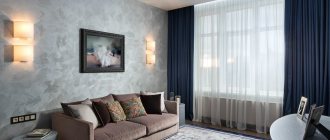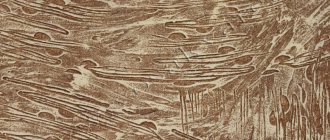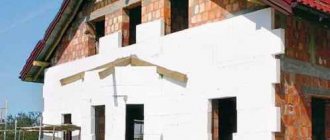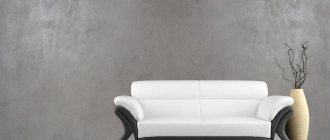Decorative plaster is a rather diverse and interesting material, despite the fact that it is used everywhere. A wall finished with plaster, depending on the type of material, can have a different texture, color, look modest and discreet, or, on the contrary, very expensive. Marble decorative plaster is one of the types of decorative surface finishing. It is used for various purposes, including finishing facades.
Marble decorative plaster
Marble chips
Facade plaster with marble chips
Such mixtures are very diverse. And usually decorative effects are provided precisely by the filler - multi-colored and different-sized stone chips.
The effects are ensured precisely by the filler - multi-colored and different-sized stone chips.
Features of the material
In essence, this finishing material is a dust-crumb composition that is formed during the processing of marble. There are also other components in the mixture, for example, binders. They can be polymer resins, acrylic emulsions, coloring agents, lime additives and others (responsible for preserving color, hardening the plaster, and also antifungal).
This finishing material is a dust-crumb composition that is formed during the processing of marble.
Advantages and disadvantages
The positive qualities of the material marble facade plaster are as follows:
- Versatility - applicable to all surfaces;
- Environmental friendliness and safety of the components that make up the mixture;
- Long service life - paint with marble chips for the facade does not crack, there is no influence of humidity and changes in temperature, alkali-resistant;
- Fire safety – not subject to combustion;
- Manufacturability – easy to prepare, accessible and not difficult to master.
The main disadvantage of marble plaster for facades is its high price.
Typically, the finished coating requires final treatment with varnish or wax.
Paint with marble chips for the facade does not crack, there is no influence of humidity and changes in temperature, alkali-resistant.
Silicone
Already in the name lies the main material - silicone, or rather silicone resins that bind the components. Such a coating will have self-cleaning properties and will also look great even when exposed to ultraviolet rays. These compounds perfectly repel water, thanks to which it flows evenly, collecting in drops, without leaving marks on the surface.
These are ready-made mixtures that are diluted by adding a certain amount of water. The coating will be resistant to contamination, yet easy to clean and will withstand household chemicals normally.
Silicate
The most resistant material to the development of mold and mildew. The plaster, which contains “liquid glass,” tolerates different temperature conditions well and is easy to apply. It can have many colors and shades. One of the main qualities can also be called the fire resistance of the material: it does not burn, does not melt and does not support combustion, which means it is safer for finishing than paper wallpaper, for example.
In addition to compositions, decorative plasters can be classified according to aesthetic qualities. They are divided into:
- flock;
- structural;
- textured.
These are all ready-made mixtures interspersed with large or small particles. Thanks to them, you can create a variety of coatings.
Color range of marble mixture
Until recently, only a crumb of a natural shade was used in plaster, so there was no color variety. Also, the compositions of different releases were usually not the same in color, since the extracted marble layers were heterogeneous.
Now the problem has been solved: there are technologies by which the material acquires a natural color or shades close to natural.
Thanks to such technologies, there is enormous potential for bringing all kinds of design ideas and solutions to life. Today, in addition to the variety of natural shades, there are thousands of artificial ones. It is possible that marble chip plaster may consist of a unique assortment of colors.
Today, in addition to the variety of natural shades, there are thousands of artificial ones.
Types of material
Plaster compositions with crumbs include materials containing granules. In fact, these are many well-known finishing mixtures for decoration, with the exception of colored ones, with a smooth surface of one shade.
There are different sizes of the solid component of plaster. The properties of the final solution correspond to which fractions are involved in production. Groups:
- Fine-textured - grain diameter less than 0.5 mm. This is dust, the smallest fractions. A well-known type of group is Venetian, silk finishing; they contain stone chips, but are finely ground; in addition, there are silk and cotton fibers.
- Fine-textured - granules 0.5-1 mm. Create a decorative effect. These are classic compositions for obtaining relief, helping to achieve a uniform rough texture.
- Medium-textured - diameter 1.5-3 mm, you can make patterns, even recreate types of surfaces. These are furrowed-rough compounds - bark beetle, Munich beetle. Reliefs are created thanks to large particles and their distribution with a grater or spatula.
- Large-textured - granules 3-5 mm, form pronounced patterns. Only particles of large fractions of different bright colors are used for the composition. Often these are pebbles of the same diameter. The material is used for external finishing; the filler is pre-treated to obtain smooth spherical granules.
Finishing with different types of plaster
Where is it used?
Decorative plaster with marble chips is used at the start and finish of interior or exterior work of a room.
As a result of application, it looks discreet, however, stylish and impressive. It is suitable for finishing brick, concrete, plasterboard, wood, DS-boards and stone. And it stays on with water emulsion!
This material will help to create an aesthetic design on balconies, beautifully decorate colonnades, etc.
As a result of application, it looks discreet, however, stylish and impressive.
Nevertheless, such plaster is rarely used inside a residential building - it is considered “cold”. But the halls, staircases, corridor rooms with the use of material in the design - plaster with marble chips - seem harmonious. It also makes the facade very advantageous.
Halls, staircases, corridor rooms with the use of material in the design - plaster with marble chips - seem harmonious.
Polymer
Mineral chips are added to these plasters. Decorative plaster granite chips have low abrasion resistance, but have a magnificent appearance. Due to this, it is used for finishing walls that do not bear a functional load. Decorative granite plaster is well bonded. Granite chips adhere perfectly to the polymer and form a uniform, beautiful layer after application. Most often, acrylic is added to the polymer mixture, as it has high decorative properties and also creates a thin film, which improves the strength of the coating.
Wall decoration with marble plaster
Coating with such material is a responsible matter, it requires a careful approach, and as a result it can have different textures, color saturation, look discreet or, on the contrary, very expensive.
Coating with such material is a responsible matter and requires a careful approach.
Surface preparation
To do this, do the following:
- Clean the wall, remove the finishing, dismantling parts of the material that were not firmly fixed. The cracks are opened and primed. Then the holes are filled with gypsum or cement;
- Apply primer to the base. To ensure uniformity of the material, the wall is completely leveled with plaster, then dried and treated with a covering primer.
To ensure uniformity of the material, the wall is completely leveled with plaster, then dried and treated with a covering primer.
The solution is laid mechanically or manually
Manual coating
A small amount of the mixture is grabbed from the container with a small spatula, then evenly distributed over the pointed part of the wide one and applied to the surface with rubbing movements with minimal force. The optimal layer thickness is one and a half diameters of coarse-grained crumbs in the material.
The optimal layer thickness is one and a half diameters of coarse-grained crumbs in the material.
Mechanical method of finishing the surface with marble chips
For this method, a special pneumatic crumb thrower is used. They use it this way: the nozzle of the device is placed half a meter from the surface to be treated, and the mixture is “thrown” onto it in a top-down motion. Next, you need to smooth it out with a spatula or other suitable tool.
For this method, a special pneumatic crumb thrower is used.
Application technology
To apply the solution yourself you will need:
- mixing container (if a dry mixture with marble chips is used);
- plastic grater;
- trowel;
- 2 metal spatulas (narrow and wide);
- building level;
- rags;
- ladder.
If you use a dry composition, then you will also need a drill with a mixer attachment for mixing.
Before decorative finishing, it is recommended to prime the surface; you will need an antiseptic primer, a roller and a ditch.
Important! The surface on which the solution is applied should have a humidity of no more than 5-10%. It is advisable to start exterior finishing work in the warm season, in dry weather.
Procedure:
- Old finishing material is removed from the walls. Inspect surfaces. Mold-affected areas are cleaned and coated with antifungal agents. Cracks, crevices and recesses are sealed with cement mortar.
- Next, the walls must be coated with quartz primer to increase adhesion. They proceed to the next stage after the primer has completely dried (at least 12 hours).
- Mix a portion of the solution following the instructions. Please note: you need to mix the composition with the drill set to minimum speed. If desired, add color and mix again. If acrylic plasters are used, they are also mixed with a mixer before application so that the filler is evenly distributed throughout the solution.
- Apply to grain thickness
The surface is treated in small areas. Scoop the solution onto a trowel and spread it over the wall in an even layer. The tool is held at an angle - the smaller the angle, the thinner the layer. The thickness of the layer should be equal to the thickness of the mineral grain, i.e. from 1.5 to 3 mm. If you make a larger one, the mass may fall off the wall due to its own gravity.
- Try to align in one direction and join areas while they are wet.
- A quarter of an hour after application, the area is leveled: a metal or plastic grater is pressed to the surface, made in a circular motion with light pressure, and the marble chips are finally smoothed out.
The plastering procedure is shown in the video tutorial below:
The solution dries over the next 24 hours, after which the finished coating can be treated with a protective varnish.
The consumption of marble plaster depends on the size of the chips, the thickness of the layer and some other parameters. On average, it takes up to 1-2 kg of fine-grained, 4-5 kg of medium-grained and up to 8 kg of coarse-grained mortar to process 1 m².
Ready-mixed marble plaster
For the convenience and speed of finishing the façade of a building, specialists actively use materials manufactured by the manufacturer. The following are in demand in the professional market:
- "Travertino";
- "Ferrara Design";
- "Novacolor";
- "Paladio Arabascato";
- "Gold Mineral" and many others.
How to apply them in practice? According to the attached instructions, add the required amount of water and mix the mixture.
Such compositions eliminate miscalculations in tone, even if there is still a need to purchase a certain amount of material - decorative marble chips plaster.
For the convenience and speed of finishing the façade of a building, specialists actively use materials manufactured by the manufacturer.
Depending on filling
Based on the purpose of the stone, it is selected. Relief patterns are formed using fine- and medium-textured plaster. In this case, choose a neutral colored granule. As for color, it is more important for fine- and coarse-textured plaster.
The most common fillings are:
1. A rock such as granite, and the more full-color materials it contains, the darker and more uninteresting the color. This material is used for cladding façade and interior parts; as for dust and crumbs, they are used to make decorative plasters.
2. Marble is a popular filler. Minerals and organic matter in its composition affect the color of the material and its properties. It is for this reason that it is used to create a relief type of plaster, as well as for thin-layer types.
3. Quartz silicon dioxide. It is used as sand in plaster. This leaving is one of the main ones.
- The wire
- Screw and piston compressors - recommendations from experts on their selection and use
- 3D turnkey fences
4. Malachite, which is based on copper dihydrocarbonate. Thanks to this component, the material retains excellent color and all kinds of tints.
5. Serpentine, in which there are many shades of green, gray-green. Used when making mosaic plaster.
6. Jasper for large-textured mosaic plasters, used in a wide variety of colors.
7. Lemezite, with the usual gray color, for cladding buildings.
8. Gabbro is also used for facing work. Its main colors are black and dark green.
9. Ophicalcite, gray-green.
Look at the variety of options, and get inspired by the photo of stone chip plaster!
How to make your own mixture at home
Yes, this is also possible, and in certain situations it is even preferable.
Making mineral plaster yourself will significantly save your money.
You will need a container where the actual material itself—plaster made from marble chips or flour—plus a “binding” substance (light-colored cement or lime will do) and water are mixed in a ratio of 3:1:1. The resulting mixture is an excellent option for simulating marble facade plaster.
Making mineral plaster yourself will significantly save your money.
Additional façade painting using marble chips
After the applied material has dried, the surface is rubbed clean using a specially designed metal float. Next, to achieve maximum coating strength, a special varnish is applied in thin layers.
The structure of the mixture allows you to visually disguise small flaws.
In practice, it is easier to treat the façade of a building with the material described here than with conventional plaster. There is no need to ensure that everything “lays down” perfectly evenly. The structure of the mixture allows you to visually disguise small flaws.
